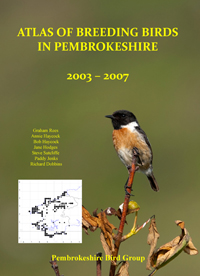Great Black-backed Gull - 2003-07
 Wednesday, May 9, 2012 at 6:11PM
Wednesday, May 9, 2012 at 6:11PM Great black-backs are top predators on the seabird islands, taking eggs and chicks of other species, and are regular predators of Puffins, Manx Shearwaters and Rabbits. They nest in single pairs or loose colonies, the former preferring prominent places on the top of rocky outcrops, while those in colonies will select dense vegetation on the top of the islands. Over 90% of the Pembrokeshire pairs breed on the offshore islands with rest as scattered individual pairs around most of the county coastline.
Numbers of these gulls have fluctuated widely. Apparently very small numbers were present in the county in the late 19th Century (Harrison & Hurrell, 1933) but by 1949 they could be found all around the coastline and especially on the islands, where Lockley et al (1949) found 310 pairs on Skomer, Middleholm, Skokholm, Grassholm and St Margaret’s combined. Davis (1958) reported between 490 and 520 pairs in the county following an all Wales survey and they continued to increase with 542 pairs recorded in 1969’s Operation Seafarer (Cramp et al 1974).
Control measures in the 1960s and 1970s on Skomer and Skokholm, followed by a botulism outbreak in the early 1980’s, reduced numbers to a low of about 140 pairs in the mid-1980s. There has been a steady but slow recovery since then and the population had risen to around 300 pairs in 2000 but has subsequently remained stable, except on Skomer where it has declined by about a third. The mean breeding success recorded on the Pembrokeshire islands in the ten years to 2005 was 1.15 to 1.29 chicks per pair, by far the highest success rate in the UK during this period. In consequence there has been a steady recovery since the 1980’s and the population in the county had risen to around 300 pairs in 2000 and has subsequently remained stable at around this number.
Steve Sutcliffe

Fieldwork 2003-07 (based on 490 tetrads)
Red = breeding confirmed = 21
Orange = breeding probable = 9
Yellow = breeding possible = not included
Total tetrads in which found = 30 (6.1%)


Reader Comments